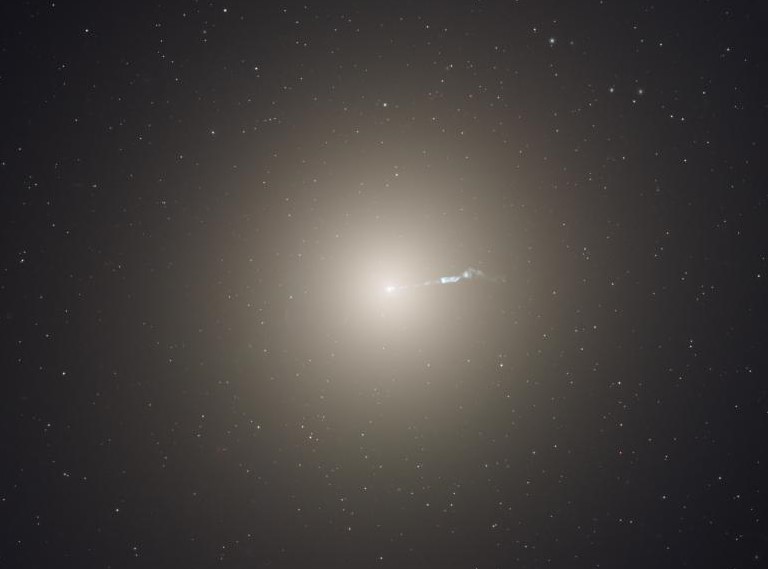The last breaths of massive galaxies

The IEEC researcher at ICE-CSIC Mar Mezcua participated in this research together with astronomers from the Instituto de Astrofísica de Canarias (IAC) and the University of Southampton
A team of astronomers propose a scenario in which galaxies with active cores may undergo a period of rapid star birth before shutting down completely. The research, conducted by astronomers from the University of Southampton, the Instituto de Astrofísica de Canarias (IAC), and the Institute of Space Sciences (ICE-CSIC), was published in Monthly Notices of the Royal Astronomical Society today.
The study suggests that galaxies with an Active Galactic Nucleus (AGN) – hosting continuously growing black holes that emit large amounts of energy and radiation – have temporarily increased the rate at which they form stars by accumulating fresh gas from their surroundings.
“The cause of halting star formation in galaxies is an ongoing and continuously debated mystery”, says Dr. Mar Mezcua, researcher from the Institute of Space Studies of Catalonia (IEEC — Institut d’Estudis Espacials de Catalunya) at ICE who participates in this study.
The Universe is filled with trillions of galaxies, each one comprising billions of stars. Until now, most data show clear evidence that star formation in galaxies steadily declines with time, but the new research shows evidence for a sudden increase in star formation just before it shuts down.
Most — if not all — massive galaxies are believed to harbour supermassive black holes at their centres. When supermassive black holes are actively accreting gas, they can radiate as much energy as the galaxy in which they reside. The popular picture is that powerful winds and jets produced by the central AGN are able to expel or heat gas within the host galaxy, removing the material needed to make stars.
The team used new data analysis techniques equipped with a large sample of more than three thousand nearby active galaxies hosting AGN to measure how the star formation of the galaxies has changed over cosmic time. Challenging the expectations from the standard scenario, researchers found that nearby galaxies hosting AGN are not simply gradually quenching their star forming rate. On the contrary, they are going through a “rejuvenation phase”: most of the galaxies in the sample with active black holes show clear signatures of a rising not declining star formation rate in recent times.
Dr. Ignacio Martín-Navarro, researcher at IAC and main author of the study, comments on their findings: "Galaxies may undergo several rejuvenation episodes until they finally become quiescent. The energy cumulatively released by supermassive black holes during these rejuvenation episodes is possibly related to the observed quenching, but there is still a lot of theoretical and observational work to do until we can have a satisfactory understanding of such a complex process."
Star formation is typically extremely short-lived in cosmological terms — the period when galaxies form stars can be a hundredth of the age of the Universe, or shorter —. The team concluded that current AGN activity may be contributing to, but not causing, the observed quenching of star birth. The rejuvenation of galaxies with active nuclei may thus be the “last breaths” in the lives of galaxies, before they completely stop forming new stars.
Press release made in collaboration with ICE Communication Office.
Links
– IEEC
– ICE
– IAC
More information
This research is presented in a paper entitled “Rejuvenation triggers nuclear activity in nearby galaxies”, by I. Martín-Navarro, M. Mezcua et al., published in the journal Monthly Notices of the Royal Astronomical Society on 13 December 2021.
The Institute of Space Studies of Catalonia (IEEC — Institut d’Estudis Espacials de Catalunya) promotes and coordinates space research and technology development in Catalonia for the benefit of society. IEEC fosters collaborations both locally and worldwide and is an efficient agent of knowledge, innovation and technology transfer. As a result of 25 years of high-quality research, done in collaboration with major international organisations, IEEC ranks among the best international research centers, focusing on areas such as: astrophysics, cosmology, planetary science, and Earth Observation. IEEC’s engineering division develops instrumentation for ground- and space-based projects, and has extensive experience in working with private or public organisations from the aerospace and other innovation sectors.
IEEC is a private non-profit foundation, governed by a Board of Trustees composed of Generalitat de Catalunya and four other institutions that each have a research unit, which together constitute the core of IEEC R&D activity: the Universitat de Barcelona (UB) with the research unit ICCUB — Institute of Cosmos Sciences; the Universitat Autònoma de Barcelona (UAB) with the research unit CERES — Center of Space Studies and Research; the Universitat Politècnica de Catalunya · BarcelonaTech (UPC) with the research unit CTE — Research Group in Space Sciences and Technologies; the Spanish Research Council (CSIC) with the research unit ICE — Institute of Space Sciences. IEEC is a CERCA (Centres de Recerca de Catalunya) center.
Contacts
IEEC Communication Office
Barcelona, Spain
Ana Montaner and Sònia Bagudanch
E-mail: comunicacio@ieec.cat
Lead Researcher
Instituto de Astrofísica de Canarias (IAC)
Headquarters: Tenerife, Spain
Ignacio Martín-Navarro
E-mail: imartin@iac.es
